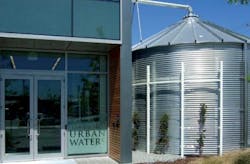PPPerfect or Problematic?
Despite well publicised issues, public-private partnerships are now growing in demand and flexibility to meet varying public sector demands. Lis Steadman speaks to major players Veolia Water and Suez Environnment to see how a variety of such projects are developing internationally, including across the Middle East, Australia and the U.S.
PPP projects, the often-complex contracts between a public-sector authority and a private consortium, have gained ground globally. The arrangement has become a way of providing substantial public services or projects for which governments or local authorities cannot or do not wish to bear the entire financial, technical or operational risk.
The division of financing and risk depends on the type of contract, though such projects are generally characterized by substantial capital input on the part of the private partner. Contracts usually provide for agreed services to be delivered. Examples include a given amount and quality of water or wastewater treated and discharged for an agreed price – and often include a range of other performance criteria unique to each project.
The form of project can also vary considerably – the facility constructed may return to the client at the end of the project, it may be transferred to the private partner, or reallocated to the same or another consortium under a further operational contract. The public partner often provides guarantees or subsidies to ensure the project is attractive to the private sector.
There have been notable and well-publicised failures of this type of partnership, and the politics and relationships between the various partners and their perceived performance have often proved crucial. The nature of the types of projects – often significant critical infrastructure – inevitably lends a political aspect that can create pitfalls for the unwary.
Flexibility in the Middle East
However, when these types of project succeed, they work extremely well as some very high-profile examples prove. Take the As Samra wastewater treatment plant (WWTP) in Jordan, which is a 25-year build-operate-transfer (BOT) agreement.
"The BOT is for financing, building and operating the biggest wwtp in Jordan. The plant serves 2.2 million people in Amman and other cities, about 40% of Jordan's population," says Hassan Abdallah, the general manager.
Treated wastewater produced is fully re-used for irrigation, and represents around 10% of Jordan's total water resource, which gives an indication of its strategic importance.
The client is the government of Jordan, which is represented by the country's Ministry of Water and Irrigation. "That's our daily link," Abdallah explains. "It is considered a national project."
Degrémont, a Suez Environnement subsidiary, is partnered by CCC Group on the project, one of the biggest M&E contractors in the Middle East, via Morgani, a US-based affiliate. The project agreement was signed in December 2003, with construction beginning immediately on the plant.
"The plant was the first BOT in Jordan, and the first financed by a Jordanian bank," Abdallah explains. This $60 million loan was augmented by a $105 million USAID contribution to the government of Jordan (see page 27). The plant not only produces wastewater to a standard higher than WHO guidelines and Jordan's own standards, but treats the resultant sludge to a high level and has a sophisticated odour control system.
PPPs often have complex interrelationships between the parties and the elements of the project and this one are no exception. Degrémont has three roles – firstly as an investor in the project, with 10% of the total investment in the project for the consortium, some $17 million (Suez Environnement and Degrémont and Morganti).
The company's second role was as leader of the PPP consortium during construction, a role shared equally with CCC Group. The third and final role is as operator, again with the CCC Group – Degrémont has 51% of the operating element, which has a further 20 years to run.
A BOT is a specific type of PPP, in which the private partners provide the management of the financing, then build and operate the system for a number of years. After this it is handed back to the client, in this case the Jordanian government. "The private sector ensures this, so we design, finance, build and operate for a number of years, and afterwards the asset is handed back to the government."
The As Samra project also benefited from USAID funding, which was given to the Jordanian government and helped to make the project more feasible and the tariff more affordable. The international to local staff ratio should be noted. Initially there were few local staff but now, three years into the operational phase, there are only two expatriate staff out of 170 employees. The team does however also have the benefit of backup from Degrémont's experts if needed, he notes, to enable optimal solutions and options to be chosen.
Because the contract shares risks and rewards, there was an incentive on both sides to find the optimum affordable treatment options. The result is fully-integrated energy recovery that generates 98% of the site's electricity requirements from both the digester system biogas and – unusually – hydropower from the inlet and outlet streams, which is possible because of the sloping terrain. This, and other moves such as minimization of chemical usage, has enabled an extremely competitive treatment tariff.
Public Sector Commitment
Joubrane Ouechec, the senior executive vice president of CEMME- near East (the Central Europe Mediterranean Middle East Business Unit of Suez Environnement) explains that the company's approach is to look for a "very high level of involvement and commitment on the part of the public sector authority".
He notes: "When managing a public sector project they should have significant involvement throughout."
The company is and has been involved in different types of PPP in different contexts: for instance, operation and maintenance contracts where the consumer fees would not cover the capital costs. This includes BOTs like As Samra, where there is a requirement for sustainable improvements, mainly for high CAPEX infrastructure projects. In lease contracts he observes that "in the French affermage, the utility must generate enough revenue through water and wastewater bills to cover CAPEX and OPEX costs".
The objective is to consolidate the partnership with the government and authorities, he explains, and to generate trust for the future. The firm is already a serious partner of the Jordanian government.He stresses that there must be long-term benefits for both parties. "The benefit for the country is the experience of the private sector – we don't come alone, we come with expertise in financing methods, PPPs in other countries, reuse, energy consumption optimization and high level of energy recovery, operations and maintenance and experience in how to be sustainable overall."
The ability of the private sector to provide engineering optimization allows long-run cost reductions in operations. "In the end, in the water sector, these issues are social and ultimately a political issue," he adds, noting: "We never interfere with the tariff build-up – we allow the public sector to feel comfortable controlling these issues."
Sometimes groundbreaking PPPs – As Samra was the first in Jordan – require special laws as well. "For As Samra there was a special decree by the government to cover the provision contract," Ouechec notes. He believes the region is realising the benefits of PPPs, and this decree helped put the project on the ground fast rather than wait months or years for global PPP laws to be implemented. This was very beneficial to Jordan.
Suez Environnement is also in the prequalifying stage for the Jordan Red Sea project, which will create a new type of partnership. "The idea is to concentrate on selecting a partner – the bidders will not have to submit a tariff for the cubic metres per hour but a file of proposals and innovations that will allow the public sector to select a partner, then go together for finance and phasing of the scope of works." He says such a new type of partnership is one the firm finds interesting.
PPPs Down Under
The preliminary aspects of PPPs are also fascinating. Bénédicte Colin is the General Counsel for Suez Environnement/Degrémont's Melbourne desalination project. Degrémont and Suez Environnement are part of the winning Aquasure Consortium, with Australian construction company Thiess and financiers Macquarie Group. Design and construction of the plant is planned for completion by December 2011 via a Thiess-Degrémont joint-venture, with subsequent operation through a Dégremont-Thiess Services joint-venture.
Colin notes that "the state of Victoria has a strong culture of PPPs – this is the 19th or 20th project under this model since 2000".
She explains that the "well balanced" consortium's inclusion of a prominent financial adviser "has been critical – we were financing the project at one of the worst times, in the global crisis".
The project was awarded in July 2009 but in reality work began more than a year before. "It was a very competitive process – the key element in Victoria's partnership policy is a very competitive partnering process," she adds.
This involved a "two to the wire" process in which two consortia were chosen from the original shortlist, with both parties producing a preliminary bid in March 2009 and a second 'best and final' bid that June.
Both bidders had to provide fully-documented bids and demonstrate their assets covered the whole life of the projects and beyond. The state had to the option to take either consortium.
"It was very competitive – we had to be very reactive. From the time of the first bid to the award there was a whole process of meetings with the state, and we were given the opportunity to adjust the bid and achieve the best project profile for the state and for the entity,' adds the General Counsel.
Both bidders had to demonstrate that their assets covered the whole of the life of the projects and beyond, because the intention was that they be handed back to the state, she adds.
Within the overall contract, there are two separate joint ventures – a 65:35 Thiess-Degrémont construction phase element, when Thiess's construction expertise prevails, and a 60:40 Degrémont-Thiess operational phase, when Degrémont's operational expertise dominates. Both parties do, however, have input to both elements of the contract.
As the contract was awarded for a unified 30-year construct-operate period following a severe drought in Victoria, there was also a significant incentive to complete construction efficiently and maximize the operational phase. Thus, a target 28 month construction phase was set, which Colin observes "is very challenging because the contract has to produce water by the end of this year". This is followed by a six month reliability testing phase.
A robust model?
The attraction of Victorian PPPs is that if a company is involved in one, the framework is essentially the same for any other so it will be a familiar process, she adds. She also notes that in the PPP it is not just the private party that has obligations. "The state of Victoria has obligations too – there are mutual obligations in the project deed, which is the overall umbrella contractual framework."
She adds: "Victoria really is one of the most sophisticated states in terms of PPP contracts. It has a well known, demonstrated and robust model."
Victoria also provided useful backup in obtaining financing in a difficult market, Colin adds. There was a stipulation that the bid had to be fully financed. The consortium found two Australian banks prepared to finance the project, but only over the short-term. The State stepped in to guarantee its help if syndication of the financing proved impossible, and she notes that for lenders "psychologically this helped us to finance over 100% of the deal". Syndication was completed less than three months after financial close and was significantly oversubscribed, after which the State's syndication guarantee obligation fell away.
Regulated Businesses in the U.S.
In the U.S.'s highly-competitive market, PPP contracts have to be both flexible and imaginative as Veolia North America executive vice president and chief municipal operations officer Philip Ashcroft explains.
"In the U.S., there are both regulated and unregulated businesses – there are a lot of regulated businesses but the PPP model is certainly growing. It came out of contract operations, but is moving beyond that to adding value for the client through different models such as asset management," he says, before adding: "There is a particular focus on PPPs for wastewater."
"For some reason municipalities were more comfortable with contracting out wastewater, but that is changing, though it is still mainly about running the plant."
The PPP model used is becoming increasingly flexible, as demonstrated by a recently-won Veolia contract in Buffalo, New York. Here, the utility workers remain employees of the city, with a Veolia management team managing them through the city supervisors. "It suits Buffalo and a number of other municipalities," Ashcroft observes.
Large scale DBO
Veolia's Tampa Bay contract in Florida is the biggest DBO in the U.S.. The original contract went so well that a second phase, doubling the original 66 MGD (250,000m3/day approx.) capacity, has just gone operational. Tampa Bay Water is the wholesaler, providing treated water to the local region.
Executive VP of Communications Scott Edwards explains that Tampa Bay Water was projecting a $200 million budget for the first phase, but the efficiencies inherent in this approach meant the actual sum required was $120 million. "That is significant and not uncommon," he adds.
The company is also talking to utilities in water-short California, as well as being involved in a project in Honolulu. The latter takes wastewater from the client's wastewater treatment plant, and treats it to two standards – part of the flow is treated for irrigation, and the other to an extremely high standard for use in a local refinery. In Oklahoma City, the firm is recycling wastewater to be used to irrigate a local country club's grounds.
A Water Impact Index, trialled in Milwaukee, has also been launched. This is a cradle-to-grave analysis of any production process, from the direct and indirect impacts of water abstraction on the watershed to the stress created by the effluent discharged on the receiving water body.
Ashcroft says: "Milwaukee is the largest PPP for wastewater operations in the U.S.," which he says involves a great deal of above-ground asset management. He says another area where the private sector can help is the reuse of biosolids, increasingly being affected by tight requirements currently in Europe and U.S..
In Milwaukee, the dried pelletized sludge is a sought-after fertiliser, and the company has also leveraged opportunities to generate power, recently winning a major contract in Hong Kong on that basis.
Ultimately, Ashcroft argues that in the U.S., PPPs provide more local control than is possible through a regulated utility. "In the regulated model, the utility sets the rate and ownership of the assets is with the regulated company, control is not with the local community. With the PPP model, ownership of the assets remain with the municipality – they decide the rates, and what and when to invest."
In the independently-minded U.S., this is an attractive prospect. Despite the odd hiccup, the wide varieties of PPP contracts are clearly still in demand and evolving constantly to meet new requirements and scenarios. With many major projects now under way, the future looks extremely promising for this most flexible of models.
The As Samra wastewater treatment plant in Jordan serves 2.2 million people in Amman and other cities, about 40% of Jordan's population
The Melbourne desalination project was won by the Aquasure Consortium, comprising Degremont and Suez Environnement, with Australian construction company Thiess and financiers Macquarie Group.
More Water & WasteWater International Current Issue Articles
More Water & WasteWater International Archives Issue Articles


